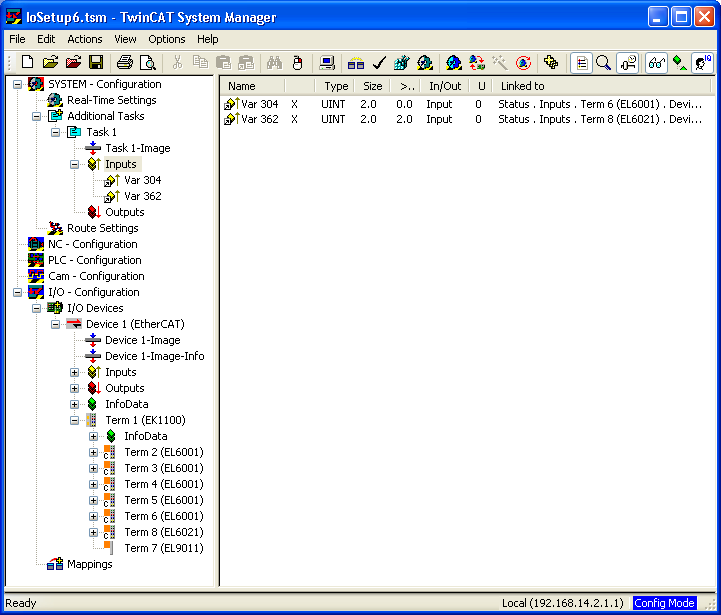Configuration with System Manager
Parameter of virtual COM port

The System Manager provides the EL60xx configuration tab for bus terminals of type EL6001 and EL6021. Figure XX shows this tab. For EL60xx terminals with checked "Virtual Com Port" check box TwinCAT creates on configuration activation a virtual serial COM port. The number of the COM port is defined in edit field "Com Port". Note, that a com port number must be unique within a computer. The computer on which the virtual com port should be created must not have a com port with this number. System manager starts with com port number 6. The com port number must be less than 65536.
Edit field "Host Ams NetId" determines the computer on which the virtual com port should be created. By default the local computer is used, which is the one where the configuration is activated and with which the bus terminal is connected. It is also possible to create the virtual com port on another computer just by changing the "Host Ams NetId" respectively. Note, that the TwinCAT-Virtual-Serial-COM-Driver has to be installed on this computer.
Within "Com Port Settings" panel one can change the common parameters of a com port, i.e. baud rate, parity, data bits, stop bits, and also flow control settings as RTS/CTS, Tx XON/XOFF, and Rx XON/XOFF. The bus terminal is initialized with the configured parameters on TwinCAT activation. However, usually applications that open a com port will also reconfigure it with their own default settings overriding the settings from system manager.
Not all possible combinations of parity, data bit count and stop bit count are valid. The following table lists the allowed combinations:
- 7 data bits, even parity, 1 stop bit
- 7 data bits, even parity, 2 stop bits
- 7 data bits, odd parity, 1 stop bit
- 7 data bits, odd parity, 2 stop bits
- 8 data bits, no parity, 1 stop bit
- 8 data bits, no parity, 2 stop bits
- 8 data bits, even parity, 1 stop bit
- 8 data bits, even parity, 2 stop bits
- 8 data bits, odd parity, 1 stop bit
- 8 data bits, odd parity, 2 stop bits
In addition to common parameters there are some proprietary settings for an EL60xx bus terminal, i.e. "Transfer Rate Optimization" and "Fifo threshold". With enabled "Transfer Rate Optimization" the bus terminal first collects enough data to fill the available space in the process image before it is sent to the TcIo driver. With disabled "Transfer Rate Optimization" the data is sent as soon as possible to the TcIo driver. The "Fifo Threshold" setting determines when the bus terminal indicates "Fifo Full" state.
Parameters of the EL6021 bus terminal are somewhat different. Therefore, the configuration dialog differs:

The EL6021 does not support RTS/CTS handshake. It does support a half-duplex mode and it can be configured for point to point connections.
For more details on the special settings refer to bus terminal documentation of EL6001 and EL6021.
Dummy Task

In order for the TwinCAT IO driver to take the process data from a terminal into account, at least one variable of the process data, e.g. the status word "Status", must be linked with a variable from an "Additional Task". If no explicit link exists, the TwinCAT IO driver ignores the process data of the terminal.
In the screenshot above, this additional task has a variable for each virtual COM interface linked to the status word of the corresponding terminal. The "Auto Start" parameter must be enabled for the task. The setting in the "Cycle Ticks" field determines how often the variables are updated. To ensure that the full data rate can be achieved during communication with the terminal, the cycle time should be in the range of 1 ms.
